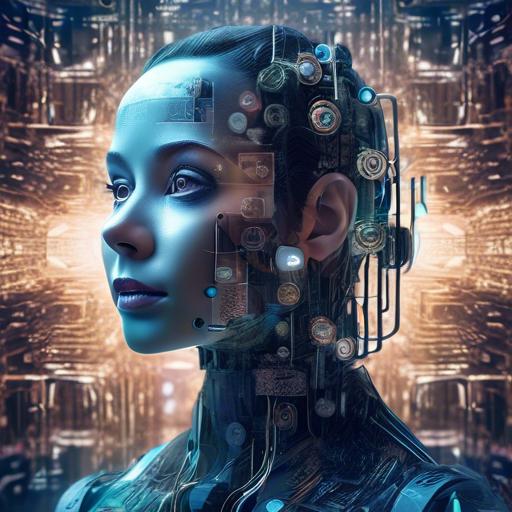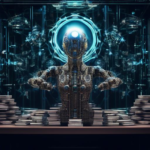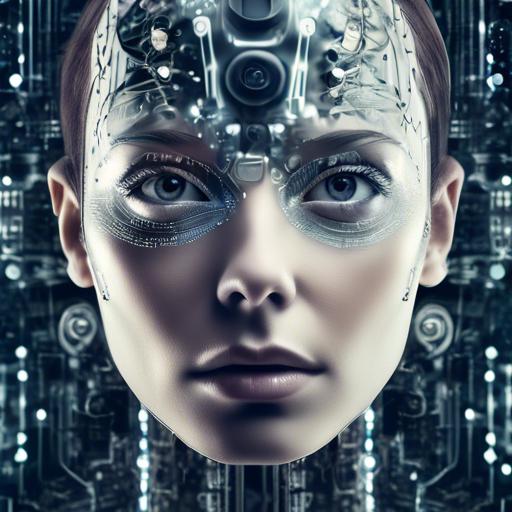In an age where algorithms dance on the canvas and pixels become the paintbrushes of modern art, the fusion of artificial intelligence and creativity has unlocked doors to boundless possibilities. However, alongside this remarkable evolution lies a labyrinth of ethical quandaries waiting to be unraveled. How do we ensure our digital da Vincis uphold the same moral integrity as their human predecessors? Enter the realm of ethical AI art promotion—a journey of balance, understanding, and conscientious stewardship. This article aims to illuminate the path forward, guiding artists, developers, and enthusiasts alike in fostering a responsible and principled approach to AI-driven artistry. Together, we can shape a future where technology and creativity coalesce not just beautifully, but ethically.
Table of Contents
- Understanding Ethical Implications in AI Art
- Establishing Clear Ethical Guidelines for Creators
- Emphasizing Transparency in AI Art Creation
- Ensuring Fair Use and Credit for Original Artists
- Balancing Artistic Freedom with Responsible AI Practices
- Fostering Continuous Education and Ethical Awareness
- Building a Collaborative Ethical Art Community
- Encouraging Accountability and Public Discourse
- Key Takeaways
Understanding Ethical Implications in AI Art
Grappling with the ethical intricacies of AI-generated art requires us to acknowledge several key concerns. AI algorithms learn from existing artworks, raising questions about **copyright infringement** and **originality**. Artists investing years in mastering their craft may find their work appropriated, with AI imitating their unique styles without due credit or compensation. This generates a pressing need to establish ethical practices that ensure fair recognition and reward.
- Informed Consent: Artworks used to train AI should come from sources that explicitly allow their use.
- Transparent Attribution: Any AI-generated art mimicking an artist’s style should clearly attribute the source of inspiration.
- Fair Compensation: Establish mechanisms to compensate original artists whose work contributes significantly to AI training datasets.
Ethical AI art also delves into deeper societal implications. For one, the potential for **reinforcing biases** remains a critical issue. If training datasets are inherently biased, AI-generated outputs will similarly reflect those biases, perpetuating stereotypes and sometimes even pushing harmful narratives. Ensuring a diverse and inclusive dataset can mitigate some of these effects and promote a more equitable representation in AI-generated art.
| Ethical Concern | Potential Solutions |
|---|---|
| Copyright Infringement | Use licensed datasets, introduce royalties |
| Bias Reinforcement | Diverse and inclusive input data |
| Lack of Attribution | Clear labeling of AI-generated work |
Moreover, fostering ethical standards requires an ongoing dialogue between **artists, tech developers, and policymakers**. Artists should have a seat at the table when discussing AI’s role in the creative world. This interdisciplinary collaboration can establish guidelines that not only encourage innovation but also protect the rights of all parties involved. By co-designing these standards, the art community and tech industry can harmoniously push boundaries while maintaining integrity.
the ethical implications stretch to the receivers—**the audience**. Consumers of AI art should be aware of its origins, ensuring transparency. Clearly marking AI-generated art not only maintains honesty but also helps the audience grasp the evolution of creativity in the digital age. By educating the public, we can foster a more informed and conscientious appreciation of AI-enhanced artistic expressions.
Establishing Clear Ethical Guidelines for Creators
For creators diving into the realm of AI art, setting **clear ethical guidelines** is not merely an option but a necessity. A clear ethical framework ensures trust and transparency in an industry that’s brimming with potential but also fraught with uncertainties. But how does one lay down these ethical cornerstones effectively?
First, it’s paramount to establish rules that prioritize the **integrity and originality** of artwork. Creators should be encouraged to avoid overt plagiarism and ensure that any AI-generated art is a product of their unique creativity. This can be facilitated by integrating watermarking systems or using specific licenses.
- Encouragement of Originality: Utilize tools that check for originality in AI-generated art.
- Effective Licensing: Use licensing options to protect and share creative work fairly.
- Transparency: Always disclose when art is generated or partially created by AI.
Another critical aspect is fostering an environment of **honesty and openness**. Being transparent about the role of AI in art creation helps demystify the process and manages audience expectations effectively. Aligning with industry standards, such transparency should be non-negotiable.
| Guideline | Action |
|---|---|
| Originality | Use originality checking tools |
| Licensing | Apply Creative Commons licenses |
| Transparency | Disclose the use of AI in art |
Lastly, the cultivation of **respect and responsibility** within the community is indispensable. Creators should hold themselves accountable and respect the intellectual property and sentiments of fellow artists. This can be achieved by engaging in community forums, providing constructive feedback, and adhering to mutually agreed guidelines.
By embedding these ethical guidelines into the very DNA of AI art creation, we not only pave the way for more responsible and innovative creations but also foster a community built on trust and shared values.
Emphasizing Transparency in AI Art Creation
AI artists should adopt practices that foster openness and accountability. Acknowledging the role of AI in the creation process is a fundamental step. Viewers and consumers expect transparency, and it builds trust when creators share insights into the algorithms and data sets used. This not only demystifies AI art but also enhances its appreciation by highlighting the collaboration between human creativity and machine learning.
Here are several ways to emphasize transparency:
- Documenting Sources: Clearly articulate the datasets and inspirations behind the artwork.
- Explaining the Process: Provide a detailed description of the algorithms and tools employed. Consider including visual workflows or step-by-step guides.
- Attribution: Credit any collaborative inputs, including other artists, datasets, or open-source tools.
Utilizing tables can help in systematically presenting this information. Here’s an example format that can be incorporated:
| Aspect | Details |
|---|---|
| Dataset | Images from various public domain resources |
| Algorithm | GAN (Generative Adversarial Network) |
| Inspiration | Impressionist paintings |
| Collaborators | Open-source community contributors |
Transparency also extends to ethical considerations. By being open about the creation process, artists can address potential biases in the AI systems they use. Highlighting any steps taken to counteract these biases or discussing limitations of the current technology demonstrates a commitment to ethical standards.
Ensuring Fair Use and Credit for Original Artists
Original artists deserve recognition and respect for their creative efforts, especially when their work inspires AI-generated art. To support these artists, it is essential to implement and follow ethical practices. Here are some key measures to ensure fair use and credit for original creators.
- Attribute the Source: Always mention the original artist in any publication or display of AI-generated work inspired by their creations. Proper attribution acknowledges their role and talent.
- Use Licensed Content: Before feeding an AI with any artwork, ensure that the content is either in the public domain or licensed for such use. Unauthorized use of copyrighted material is a significant ethical violation.
- Seek Permissions: Contact the original artists, if possible, to obtain their explicit permission for using their work as a basis for AI training. This approach fosters goodwill and transparency.
| Ethical Practice | Benefit |
|---|---|
| Attribution | Acknowledges original creator, builds trust |
| Licensing | Ensures legal compliance, respects ownership |
| Permission | Engages artists, promotes ethical use |
Furthermore, consider the impact on the artist’s career. Highlight collaborations between AI projects and artists to bring mutual benefits. This concerted effort will not only ensure ethical use but also potentially elevate the artist’s exposure and opportunities.
educate your audience about ethical AI art practices. Encourage discussions surrounding the importance of crediting original creators and maintaining integrity in digital art spheres. By fostering a community that values and respects the contributions of all creators, we forge a future where technology and artistry can coexist harmoniously.
Balancing Artistic Freedom with Responsible AI Practices
In the midst of rapid technological advancements, artists find themselves at a crossroads between innovation and responsibility. The creative world thrives on freedom; however, the power embedded in AI-driven art demands a new set of ethical guidelines. This balance can be a nuanced dance, requiring intentional, thoughtful action to ensure that creativity does not eclipse conscience.
**Transparency** becomes paramount in maintaining this balance. Artists and developers should openly disclose the use of AI in their processes. By providing clear **credit to the original sources** of data and algorithms, creators acknowledge the human touch behind the machine’s learning, fostering a culture of respect and accountability. Transparency empowers consumers and other artists, creating a more trust-filled and ethical artistic environment.
An aspect not to be overlooked is the importance of **bias mitigation**. AI systems often reflect the biases present in their training data, leading to the propagation of stereotypes or unfair representations. Artists can take steps to minimize this by employing diverse datasets and consistently testing their outputs. Furthermore, committing to regular audits ensures that the art generated does not perpetuate harmful prejudices.
- Encourage participatory design: Engaging communities in the creation process ensures diverse perspectives are included.
- Foster interdisciplinary collaboration: Pairing artists with ethicists and technologists can lead to more well-rounded AI art practices.
- Prioritize inclusivity: Ensuring representation from marginalized groups prevents the reinforcement of societal biases.
**Respect for intellectual property** is another cornerstone of responsible AI art practices. While AI can blend and innovate based on existing works, it must do so without infringing on the original creators’ rights. **Creative Commons** licenses and other open-source frameworks offer pathways for using and sharing art legally and ethically. Implementing mechanisms to track and repay original creators for their contributions is a step towards an equitable artistic ecosystem.
Lastly, fostering an environment of continuous **education and dialogue** can play a pivotal role. Workshops, seminars, and online forums focused on AI ethics in art provide a platform for artists to learn, discuss, and evolve. These initiatives support the ongoing development of best practices and ethical standards, ensuring that the artistic freedom enjoyed by AI artists is matched by a commitment to creating responsibly.
Fostering Continuous Education and Ethical Awareness
One effective method to promote ethical standards in the development of AI-generated art is to **integrate continuous education** into the creative community. This can be achieved through **workshops, seminars, and online courses** that emphasize both the technical and ethical aspects of AI art. Encouraging artists and developers to attend these educational events ensures they stay updated on best practices, ethical considerations, and emerging technologies.
Another vital strategy is to cultivate an environment where ethical awareness is embedded into everyday workflows. This can be done by establishing **clear guidelines** and **codes of conduct** that artists and developers can refer to while creating AI art. Such resources provide a solid foundation, helping practitioners navigate potential ethical dilemmas:
-
Transparency: Clearly disclose when and how AI is being used in the creation process.
- Consent: Obtain proper permissions and respect intellectual property rights.
-
Accountability: Take responsibility for the outputs generated by AI tools.
**Collaboration** is another cornerstone in fostering ethical AI art practices. By forming partnerships between tech developers and traditional artists, a holistic approach can be achieved. Such collaborations promote a mutual understanding of ethical standards and encourage the creation of AI art that respects creative integrity and social norms. Open-source platforms and interdisciplinary forums can act as fertile grounds for these collaborative efforts.
The importance of **community feedback** cannot be overstated. Setting up mechanisms for feedback and critique allows for a diverse range of perspectives, ensuring continuous improvement and adherence to ethical standards. Including a feature for community ratings and comments on AI-generated artworks can help artists identify areas for improvement.
| Action | Outcome |
|---|---|
| Attend Ethics Workshops | Stay Updated on Best Practices |
| Follow Codes of Conduct | Guidance Through Ethical Dilemmas |
| Engage in Collaboration | Diverse and Respectful Art Creation |
| Seek Community Feedback | Continuous Ethical Improvement |
Promoting ethical standards in AI art is a multifaceted endeavor that requires deliberate commitment to continuous education and ethical awareness. By taking a holistic approach that includes clear guidelines, collaborative efforts, and community engagement, artists and developers can create a more ethical and responsible future for AI-generated art.
Building a Collaborative Ethical Art Community
Fostering a space where AI art thrives ethically requires intentional efforts and cooperation from artists, developers, and even the audience. One of the fundamental principles is openness about sources and methods. Artists should be transparent about the AI tools they use and the data sets involved in their creations. This transparency not only builds trust but also educates the community, opening doors for meaningful conversations about ethics.
Engaging in active collaboration plays a vital role. Artists and developers can work together to create AI tools that are sensitive to ethical concerns. Here, feedback loops are crucial: developers should seek input from artists on how tools perform and where ethical lines might be drawn. Similarly, artists can inform developers about specific needs or ethical dilemmas that arise, paving the way for more responsible innovation.
Consider these practices to build a collaborative ethical art community:
- Host regular discussions and workshops about ethical issues in AI art, inviting diverse voices to share their perspectives.
- Create a code of ethics for your community, detailing acceptable practices, data usage norms, and ways to address potential ethical violations.
- Encourage joint projects where artists and developers co-create with an ethical framework in mind, ensuring that every step respects the agreed standards.
- Offer resources such as articles, books, and courses on ethical AI practices to educate and empower all members.
Communication channels such as forums or dedicated social media groups can further enhance collaboration. These platforms serve as a space where members can share their experiences, challenges, and successes in adhering to ethical guidelines. They also provide a support network where questions can be asked, and collective wisdom can be accessed quickly and effectively.
Here’s a glance at potential benefits of fostering an ethical art community:
| Benefit | Description |
|---|---|
| Innovation | Encourages responsible creativity and novel solutions. |
| Trust | Builds a stronger bond between creators and their audience. |
| Education | Promotes continuous learning about ethical AI practices. |
Encouraging Accountability and Public Discourse
Fostering a culture of **accountability** and **public discourse** is crucial in promoting ethical standards within the realm of AI-generated art. This begins with transparent practices by both creators and platforms. Transparency about algorithms, data sourcing, and the creative process can demystify AI art, enabling communities to evaluate and discuss ethical implications comprehensively.
- Share Openly: Artists and developers should publish their methods and data sources to allow scrutiny and feedback.
- Encourage Critique: Healthy, constructive criticism helps identify potential biases and unethical practices.
- Engage with Communities: Participate in forums and discussions about AI art ethics to understand varied perspectives.
Implementing **community guidelines** that emphasize responsible usage and creation of AI art can serve as another key pillar. Guidelines should outline acceptable practices, explicitly discourage misuse, and offer resources for ethical decision-making. This not only sets the tone for individual accountability but also empowers the entire community to uphold these standards collectively.
| Guideline | Purpose |
|---|---|
| Transparency | To ensure open and honest sharing of practices. |
| Inclusivity | To represent diverse voices and avoid biases. |
| Responsibility | To encourage mindful and ethical creation. |
The importance of **public discourse** cannot be overstated. Regularly hosting webinars, panel discussions, and Q&A sessions focused on AI art ethics provides a platform for experts, artists, and the public to engage meaningfully. These dialogues can illuminate ethical challenges and collaboratively develop solutions, fostering a balanced and ethically sound AI art ecosystem.
Ultimately, promoting ethical standards in AI art is a collaborative effort. It requires sustained contributions from developers, artists, and consumers alike. By encouraging accountability and fostering informed public discourse, the community can ensure that AI art evolves in a manner that is innovative yet conscientiously aligned with ethical principles.
Key Takeaways
As we navigate the exciting and ever-evolving world of AI art, it is crucial that we prioritize and promote ethical standards to ensure the continued growth and integrity of this groundbreaking field. By following the steps outlined in this article, we can all play a role in shaping a future where AI art is not only innovative and inspiring, but also respectful and ethical. Let us strive to create a world where creativity and ethics go hand in hand, paving the way for a brighter and more sustainable future for AI art. Together, we can make a difference and set a new standard for the intersection of art and technology.































